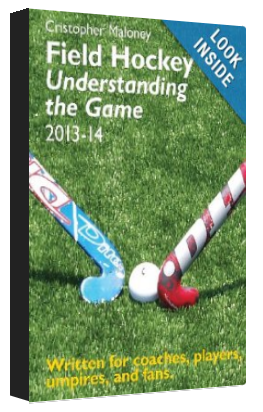Helpful Videos
The following video from a high school game in the USA debunks the "rumor rule" that some people think requires the goal scorer to get the ball after they score and bring it up to the center-line.
ED: The video above highlights how the antiquated practice in some parts of the USA that has high school coaches and players thinking that the player who scores has to go get the ball and carry it up to the center-line is fading.
The practice is supposedly done to help the umpires and scorekeeper know who scored -- as if helping the scorekeepers or the umpires is the goal scorer's job.
The appropriate procedure, for umpires and scorekeepers, if the goal scorer is not known, is for the umpire to simply ask the captain.
In NFHS rules the umpire has responsibility for reporting the goal scorer's number to the scorekeeper (which is why many people blame the origins of this practice on umpires).
Scoring goals is rather rare in field hockey. Asking a player to perform a chore after she scores is bizarre. We don't see this practice in any other sport.
Why don't we not see the behavior in college -- when high school seniors are one year older? Maybe the upperclassmen tell the freshmen, "Hey rookie. We DO NOT do THAT here. You want people to laugh at you?!?"
Despite the possible origin, the practice tends to have a negative effect on umpire concentration because umpires don't have to continue their concentration during and immediately after a scoring play. (Why bother if some kid is going to run in and get the ball?)
The practice also dulls the game. Have you seen the video of Rebecca Barry's goal for the University of Richmond? It won an ESPN award for best play -- first ever for field hockey. In scoring the goal she aerial dribbled over the goalkeeper's head, hits the ball like Babe Ruth into the cage, and pumped her hand into the air in absolute joy while running up the field to hug her teammate. Now, imagine if instead she had to turn the other way, stop, put her head down, bend over, and get the ball out of the cage. All of the "energy" of the moment would have been sucked away -- and we certainly would not have seen the video on ESPN!
The good news is that the practice is fading and it is being recognized for what it is -- immature; dumb for developing strong umpires; bad at the game's most exciting moment; makes ZERO sense for the athletes.
Coaches/Parents -- Tell your athletes/kids to stop doing it.
Goal Scorers -- Enjoy the moment. Leave the ball!
ADVERTISEMENT
Thinking about coaching or umpiring? Want to be a better player?
Do you know a bewildered parent trying to figure out what's going on?
FieldHockeyBook.comUmpireHockey.com publisher Cris Maloney brings four decades of experience as a field hockey player, coach, umpire, and event organizer to the pages of Field Hockey Understanding the Game. He coached at two USOC Olympic Festivals; served as the play-by-play announcer at numerous national and international field hockey events; taught and mentored hundreds of aspiring umpires; created and serves as editor of the Ask The Umpire feature on USA Field Hockey’s website; and is the author of the JUMP IN umpire training program.
$12.99 USD. Available on Amazon and FieldHockeyBook.com
Copyright © 2002-
UmpireHockey.com
Top of Page
|